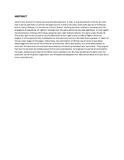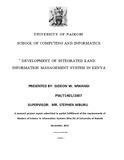/ library resources
Showing items 1 through 9 of 24.Land is very central for human survival and development. In fact, it is so elemental to human
survival that it can be said that it is where life begins and it is where life ends. Land is the source
The abundance and diversity of soil mites was monitored along a gradient of land use types (LUTs) during the wet seasons in soils of Taita Taveta, Kenya.
Land degradation is a gradual, negative environmental process that is accelerated by human activities. Its gradual nature allows degradation to
proceed unnoticed, thus reducing the likelihood of appropriate and timely control action. Presently, there are few practical frameworks to help
Climate change impacts livelihoods adversely in dry-lands of Northern Kenya in terms of longer and harsher droughts, shorter and intense precipitation and floods. Climate change interlocks with peoples life-worlds differently for different reasons.
Kenya’s land surface is primarily arid and semi-arid lands (ASALs) which account for 84% of the total land area.
The impact of land use and cover change on soil quality and pasture production was investigated
in the rangelands of Nakasongola District, Uganda, Landsat (TM) images of 1986 and 1990 and
Landsat (ETM+) of 2000 and 2004 for Nakasongola District were used to determine the extent
Land is a key asset of any country. It is one of the factors of production which includes labour
and capital. It is critical for economic, social and political development of a country. There exists
Infestation and destruction of rangeland vegetation by subterranean termites is a major constraint to livestock production in the rangelands of Uganda, particularly, in semi-arid Nakasongola.
Pagination
Land Library Search
Through our robust search engine, you can search for any item of the over 73,000 highly curated resources in the Land Library.
If you would like to find an overview of what is possible, feel free to peruse the Search Guide.







